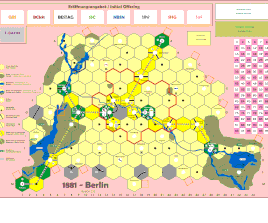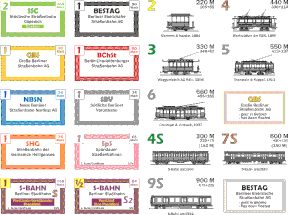18xx-MARFLOW-GAMES
1881 - Berlin
Designer | Michael Mette |
Published | 2016 |
Area | Berlin |
Private Companies | none |
Minor Companies | none |
Corporations | 9 |
Map Size | 139 hexes ( 145 total) |
Off-Board Connections | none |
Bank | 10,320 Mark |
Tiles | yellow, green, brown, grey |
Stock Market | 2D |
The game begins with a Starting Round where all players may buy up to four certificates of tramway corporations. Then the First Stock Round follows. Now the players may acquire fur-ther certificates but only from those tramway corporations of which already certificates have been bought during the Starting Round. New tramway corporations may be founded as soon as all certificates of a floated tramway corporations have been purchased from the Initial Of-fering. From the green phase onwards the S-Bahn company enters the game. The certificates of the S-Bahn company may not only be purchased by the players but also by the tramway corporations.
The S-Bahn company is the special element of 1881. The company consists of four networks, which are managed independently by the four board members. They decide about the track building and the usage of their network’s revenue. The dividend payouts of the networks are distributed among all S-Bahn certificates. During the course of the game S-Bahn networks may be merged and consequently the number of active board members is reduced. The S-Bahn rails are separated from the tramway rails which is indicated by a different design on the tiles. The S-Bahn trains cannot use the tramway rails and the trams of the tramway corpora-tions may not use the S-Bahn rails. However both type of rails may met at station hubs.
Beside the revenue from their tram operations the tramway corporations do have further in-come sources. There are one time bonuses for connecting certain suburbs with the town center. In addition tramway corporations which own S-Bahn certificates will benefit from dividends payout into their treasury.
The challenge for a player in 1881 is to create profitable tramway networks and build depots at the right stations. In addition a tramway corporation should benefit from the different in-come sources to make the necessary investments with a minimum of revenue savings. The S-Bahn company has to be managed deliberately in order to avoid pitfalls.
Historical Background
The history of the tramway started some 180 years ago, with the first horse- drawn tram, in 1828 in Baltimore/Ohio. In 1865 the first horse-drawn tram in the German countries rode through Berlin. But the heyday of the tramway came with the development of electric trams. At the world exhibition of 1879 in Berlin, the first electrical powered rail vehicle was presented by the Siemens & Halske company. No more than two years later it operated, on May 16 1881, the first “electric” one in the world, in Groß-Lichterfelde near Berlin. Soon the electric tram became the leading means of urban transportation for decades to come. In 1913 in Berlin and its suburbs, 15 trolley companies operated more than 6000 vehicles on over 150 lines.
Short Game Description



